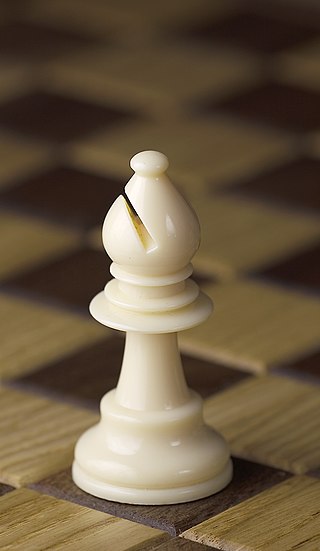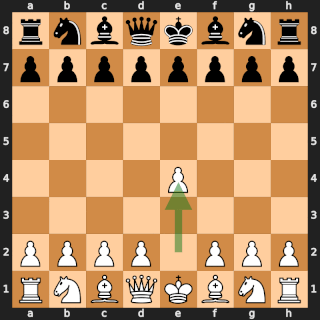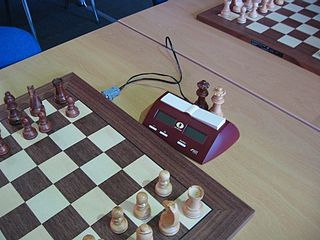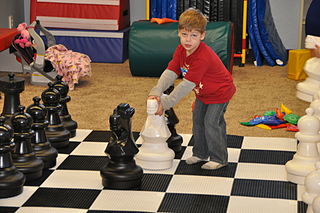
The bishop is a piece in the game of chess. It moves and captures along diagonals without jumping over intervening pieces. Each player begins the game with two bishops. One starts between the king's knight and the king, the other between the queen's knight and the queen. The starting squares are c1 and f1 for White's bishops, and c8 and f8 for Black's bishops.
Castling is a move in chess. It consists of moving one’s king two squares toward a rook on the same rank and then moving the rook to the square that the king passed over. Castling is permitted only if neither the king nor the rook has previously moved; the squares between the king and the rook are vacant; and the king does not leave, cross over, or end up on a square attacked by an opposing piece. Castling is the only move in chess in which two pieces are moved at once.
Zugzwang is a situation found in chess and other turn-based games wherein one player is put at a disadvantage because of their obligation to make a move; a player is said to be "in zugzwang" when any legal move will worsen their position.
The Plachutta is a device found in chess problems wherein a piece is sacrificially positioned in blockade to deny coverage of multiple distant squares required by the opposition. For example, two of an opponent's bishops, queen, or rooks are defending locations through an intersection square, and an enemy unit moved into that square blocks disrupts coverage in such a way that, even if captured, the previous defensive situation cannot be restored.
Stalemate is a situation in the game of chess where the player whose turn it is to move is not in check and has no legal move. Stalemate results in a draw. During the endgame, stalemate is a resource that can enable the player with the inferior position to draw the game rather than lose. In more complex positions, stalemate is much rarer, usually taking the form of a swindle that succeeds only if the superior side is inattentive. Stalemate is also a common theme in endgame studies and other chess problems.

The Opera Game was an 1858 chess game, played at an opera house in Paris. The American master Paul Morphy played against two strong amateurs: the German noble Karl II, Duke of Brunswick, and the French aristocrat Comte Isouard de Vauvenargues. It was played as a consultation game, with Duke Karl and Count Isouard jointly deciding each move for the black pieces, while Morphy controlled the white pieces by himself. The game was played in a box while an opera was performed on stage. Morphy quickly checkmated his opponents following rapid development of material, involving a queen sacrifice.
The zwischenzug is a chess tactic in which a player, instead of playing the expected move, first interposes another move posing an immediate threat that the opponent must answer, and only then plays the expected move. It is a move that has a high degree of "initiative". Ideally, the zwischenzug changes the situation to the player's advantage, such as by gaining material or avoiding what would otherwise be a strong continuation for the opponent.
In chess, a passed pawn is a pawn with no opposing pawns to prevent it from advancing to the eighth rank; i.e. there are no opposing pawns in front of it on either the same file or adjacent files. A passed pawn is sometimes colloquially called a passer. Passed pawns are advantageous because only the opponent's pieces can stop them from promoting.

In chess, promotion is the replacement of a pawn with a new piece when the pawn is moved to its last rank. The player replaces the pawn immediately with a queen, rook, bishop, or knight of the same color. The new piece does not have to be a previously captured piece. Promotion is mandatory; the pawn cannot remain as a pawn.

The touch-move rule in chess specifies that a player, having the move, who deliberately touches a piece on the board must move or capture that piece if it is legal to do so. If it is the player's piece that was touched, it must be moved if the piece has a legal move. If the opponent's piece was touched, it must be captured if it can be captured with a legal move. If the touched piece cannot be legally moved or captured, there is no penalty. This is a rule of chess that is enforced in all formal over-the-board competitions. A player claiming a touch-move violation must do so before themselves touching a piece. Online chess does not use the touch rule, letting players "pick up" a piece and then bring it back to the original square before selecting a different piece, and also allowing players to premove pieces while waiting for the opponent to move.
In chess, a half-open file is a file with pawns of only one color. The half-open file can provide a line of attack for a player's rook or queen. A half-open file is generally exploited by the player with no pawns on it.
In chess, a fortress is an endgame drawing technique in which the side behind in material sets up a zone of protection that the opponent cannot penetrate. This might involve keeping the enemy king out of one's position, or a zone the enemy cannot force one out of. An elementary fortress is a theoretically drawn position with reduced material in which a passive defense will maintain the draw.
In chess, a blunder is a critically bad move. It is usually caused by some tactical oversight, whether it be from time trouble, overconfidence or carelessness. Although blunders are most common in amateur games, all human players make them, even at the world championship level. Creating opportunities for the opponent to blunder is an important skill in over the board chess.
The chess endgame of a queen versus pawn is usually an easy win for the side with the queen. However, if the pawn has advanced to its seventh rank it has possibilities of reaching a draw, and there are some drawn positions with the pawn on the sixth rank. This endgame arises most often from a race of pawns to promote.

In chess, a swindle is a ruse by which players in a losing position trick their opponent and thereby achieve a win or draw instead of the expected loss. It may also refer more generally to obtaining a win or draw from a clearly losing position. I. A. Horowitz and Fred Reinfeld distinguish among "traps", "pitfalls", and "swindles". In their terminology, a "trap" refers to a situation where players go wrong through their own efforts. In a "pitfall", the beneficiary of the pitfall plays an active role, creating a situation where a plausible move by the opponent will turn out badly. A "swindle" is a pitfall adopted by a player who has a clearly lost game. Horowitz and Reinfeld observe that swindles, "though ignored in virtually all chess books", "play an enormously important role in over-the-board chess, and decide the fate of countless games".
The opposite-colored bishops endgame is a chess endgame in which each side has a single bishop and the bishops reside on opposite-colored squares. Without other pieces besides pawns, these endings are widely known for their tendency to result in a draw. These are the most difficult endings in which to convert a small material advantage to a win. With additional pieces, the stronger side has more chances to win, but not as many as when bishops are on the same color.
In chess, the Muzio Gambit, sometimes called the Polerio Gambit, is an opening line in the King's Gambit in which White sacrifices a knight for a large lead in development and attacking chances. It begins with the moves:
In chess endgames with a bishop, a pawn that is a rook pawn may be the wrong rook pawn. With a single bishop, the result of a position may depend on whether or not the bishop controls the square on the chessboard on which the pawn would promote. Since a side's rook pawns promote on opposite-colored squares, one of them may be the "wrong rook pawn". This situation is also known as having the wrong-colored bishop or wrong bishop, i.e. the bishop is on the wrong colored squares in relation to the rook pawn. In many cases, the wrong rook pawn will only draw, when any other pawn would win. A fairly common defensive tactic is to get into one of these drawn endgames, often through a sacrifice.

Levitsky versus Marshall, also known as the Gold Coins Game, is a famous game of chess played by Stepan Levitsky and Frank Marshall. It was played in Breslau on July 20, 1912, during the master's tournament of the DSB Congress. According to legend, after Marshall's winning last move of the game, gold coins were tossed onto the board by spectators, although this is contested by other accounts.

The sixteenth chess game in the fourth match between Alexander McDonnell and Louis-Charles Mahé de La Bourdonnais played in London in 1834 is famous for demonstrating the power of a mobile central block of pawns. Its final position is one of the most famous in the history of the game.








